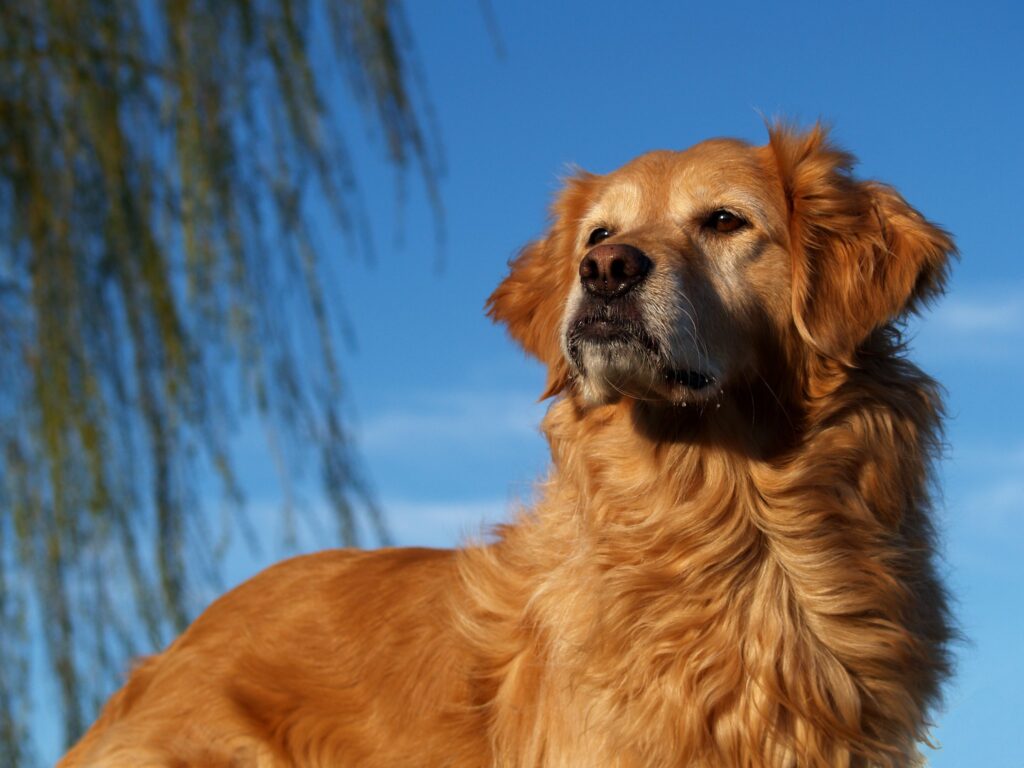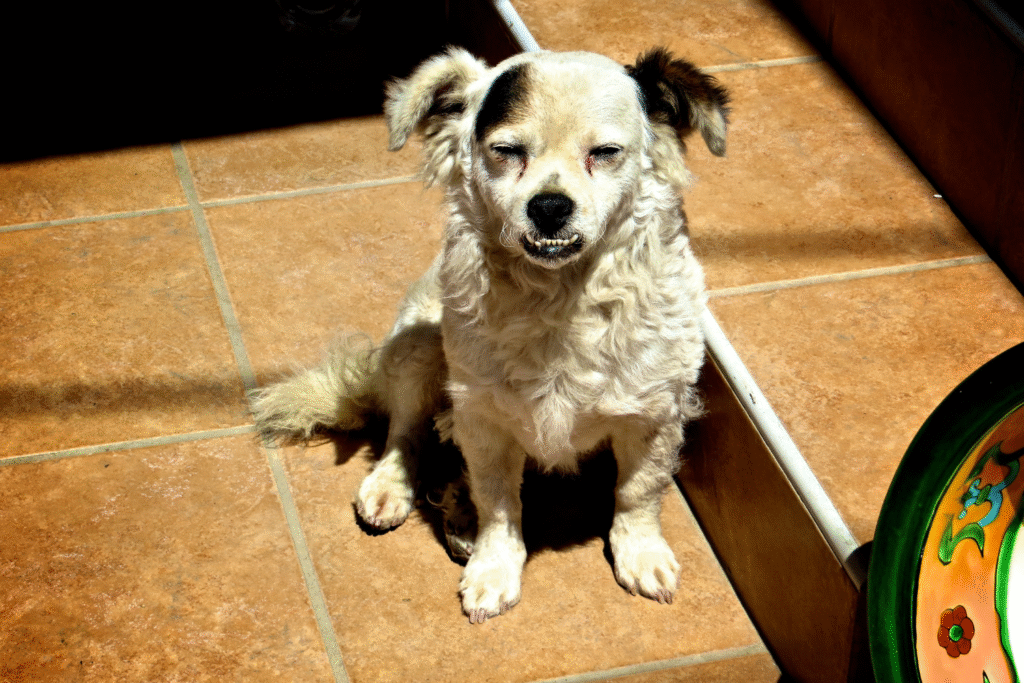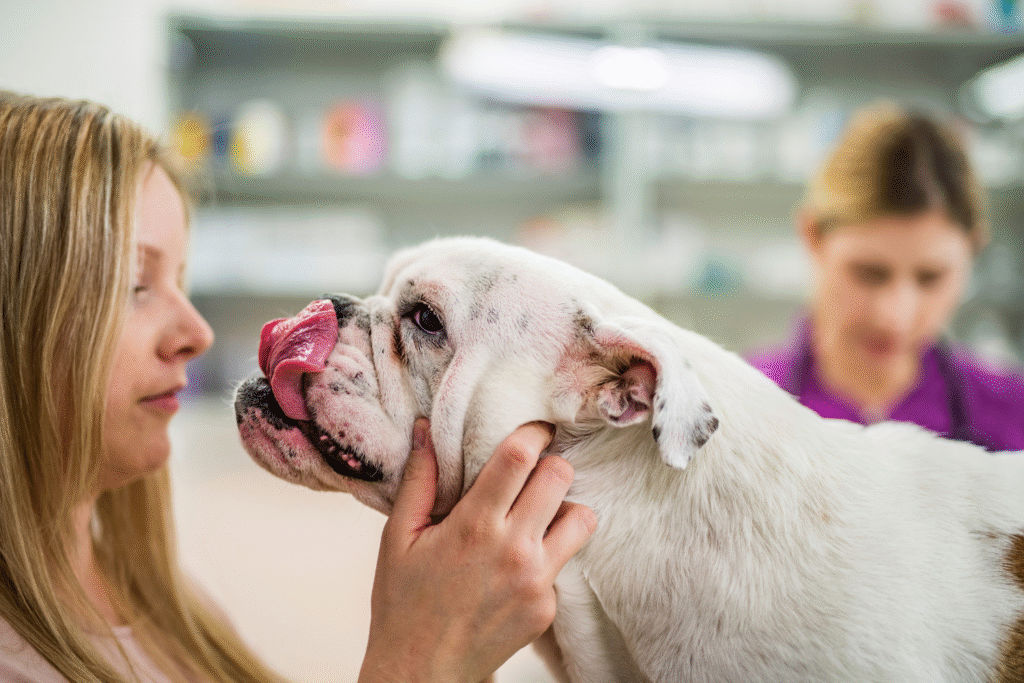Underbites tell stories about genetics and health.

That adorable lower jaw jutting out beyond your dog’s upper teeth might seem like nothing more than a charming quirk that makes their personality shine through their facial expressions, but the reality of canine dental architecture tells a far more complex story about skeletal development, genetic inheritance patterns, and potential health complications that extend well beyond cosmetic considerations.
While some underbites represent harmless genetic variations that create distinctive breed characteristics without compromising function, others signal underlying developmental issues or breeding practices that can lead to serious complications affecting everything from eating efficiency to respiratory function throughout your dog’s lifetime.
1. Brachycephalic breeds develop underbites through centuries of selective breeding for flat faces.

Bulldogs, pugs, and Boston terriers exhibit underbites as direct consequences of genetic modifications that compressed their skull structure to create the flat-faced appearance that defines these breeds, resulting in lower jaws that often extend beyond shortened upper jaws in configurations that prioritize aesthetic appeal over functional dental alignment. These structural changes occurred gradually through generations of breeding programs focused on enhancing specific facial features that humans found appealing, regardless of the functional implications for normal jaw mechanics and dental health.
According to veterinary orthodontic research published by the American Veterinary Dental College, brachycephalic underbites typically represent normal breed characteristics rather than pathological conditions, though they can create long-term complications related to dental wear, food processing efficiency, and oral hygiene maintenance that require ongoing monitoring throughout the dog’s life.
2. Genetic mutations cause underbites in breeds not typically associated with jaw misalignment.

Random genetic variations can produce underbites in breeds like German shepherds, golden retrievers, and other dogs whose breed standards call for normal scissor bites, indicating that these dental anomalies sometimes represent true developmental abnormalities rather than intended breed characteristics inherited from generations of selective breeding programs. These unexpected underbites often appear as isolated incidents within otherwise normally structured bloodlines, suggesting spontaneous genetic mutations or recessive trait combinations that manifest unexpectedly in individual puppies.
The occurrence of underbites in typically normal-jawed breeds often correlates with other skeletal abnormalities or developmental issues that may require veterinary evaluation to assess overall health impacts and breeding implications, as reported by canine genetics researchers at veterinary teaching hospitals. Such cases frequently prompt genetic counseling recommendations for breeding programs to prevent perpetuating potentially problematic traits through future generations of otherwise healthy bloodlines.
3. Severe underbites interfere with normal eating and chewing functions.

Dogs with pronounced jaw misalignments often struggle to grasp food properly, leading to modified eating strategies that include tilting their heads, using their tongues more extensively, or swallowing larger pieces of food without adequate chewing, which can create digestive stress and reduce nutrient absorption efficiency over time. These functional limitations become more pronounced as dogs age and their compensatory mechanisms become less effective at managing the mechanical challenges posed by misaligned dental structures.
Veterinary nutritionists have documented that dogs with severe underbites may require specially formulated diets, modified food textures, or feeding strategies designed to accommodate their altered jaw mechanics, according to studies published in veterinary nutrition journals. The long-term health implications can include increased risk of choking, digestive upset, and dental disease when normal cleaning mechanisms are compromised by improper tooth alignment and reduced chewing efficiency.
4. Respiratory complications often accompany underbites in flat-faced breeds.

The same genetic modifications that create underbites in brachycephalic breeds also compress nasal passages, elongate soft palates, and narrow airways in ways that can severely compromise breathing efficiency, especially during exercise, stress, or hot weather when oxygen demands increase beyond what their restricted respiratory systems can efficiently deliver. These structural limitations create a cascade of physiological challenges that extend far beyond dental alignment issues to encompass fundamental life-sustaining functions that affect daily quality of life.
Dogs with both underbites and respiratory restrictions often develop secondary health problems including heart strain, exercise intolerance, and sleep disorders that compound the challenges already created by their dental misalignment, requiring comprehensive veterinary management strategies that address multiple interconnected system dysfunctions simultaneously. The combination of breathing difficulties and eating challenges can create particularly complex health management scenarios that require specialized veterinary expertise.
5. Dental disease accelerates when misaligned teeth create cleaning challenges.

Underbites frequently prevent normal tooth-to-tooth contact that naturally helps remove plaque and food debris during chewing, leading to accelerated tartar buildup, gum inflammation, and bacterial infections that can progress to serious periodontal disease affecting not only oral health but also systemic health through bacterial spread to other organ systems. The irregular spacing and alignment patterns associated with underbites create numerous hiding places for bacteria and food particles that become increasingly difficult to clean through normal eating and chewing activities.
Professional dental cleanings become more critical for dogs with underbites because home care measures like dental chews and brushing may not reach all the problematic areas created by abnormal tooth positioning, requiring more frequent veterinary dental interventions to maintain acceptable oral health standards. The financial and health costs associated with managing dental disease in dogs with underbites can accumulate significantly over their lifetimes.
6. Jaw pain develops when misaligned teeth create abnormal pressure points.

The uneven distribution of chewing forces caused by underbites can create painful pressure points where teeth make inappropriate contact, leading to chronic discomfort that may not be immediately obvious to owners but can significantly impact a dog’s willingness to eat, play with toys, or engage in normal behavioral activities that involve using their mouth. These pressure-related problems often worsen with age as teeth continue to wear in abnormal patterns that exacerbate existing misalignment issues.
Dogs experiencing jaw pain may develop subtle behavioral changes including reluctance to eat hard foods, decreased interest in chew toys, head shyness during petting, or changes in vocalization patterns that reflect their discomfort with normal mouth functions. Early recognition and management of pain-related complications can significantly improve quality of life for dogs with problematic underbites.
7. Breeding programs perpetuate underbites through genetic selection pressures.

Commercial breeding operations and puppy mills often prioritize rapid reproduction over health considerations, leading to breeding practices that concentrate genetic traits for underbites without adequate screening for associated health problems that can create lifelong medical expenses and quality of life issues for the resulting puppies. Responsible breeding requires careful evaluation of both parents’ dental structure and health histories to minimize the risk of producing offspring with problematic jaw alignments.
The popularity of flat-faced breeds in urban markets creates economic incentives for breeders to emphasize extreme facial features that appeal to buyers seeking distinctive-looking pets, often without adequate consideration for the health implications of these structural modifications on individual dogs and breed populations. Education about the health costs associated with extreme underbites can help potential owners make more informed decisions about breed selection and breeder evaluation.
8. Surgical correction becomes necessary when underbites cause severe functional problems.

Veterinary orthodontists can perform surgical procedures to realign severe underbites when conservative management strategies prove insufficient to address eating difficulties, pain, or other quality of life issues, though these interventions require specialized expertise, significant financial investment, and extended recovery periods that may not be appropriate for all dogs or all situations. The decision to pursue surgical correction involves careful evaluation of the potential benefits versus risks for individual dogs.
Modern veterinary orthodontic techniques offer various options for addressing problematic underbites, ranging from tooth extraction to jaw repositioning surgeries, each with specific indications, success rates, and potential complications that require thorough discussion between veterinarians and pet owners. The complexity and cost of these procedures often makes prevention through responsible breeding practices a more practical approach than corrective surgery after problems develop.
9. Age-related changes worsen underbite complications over time.

As dogs mature, the functional problems associated with underbites often intensify due to progressive tooth wear, gum recession, and the development of arthritis in jaw joints that compound existing mechanical difficulties with eating, chewing, and maintaining oral hygiene effectively. The cumulative effects of years of abnormal jaw mechanics can accelerate dental disease progression and create new pain sources that require increasingly complex management strategies.
Senior dogs with underbites may require significant dietary modifications, pain management protocols, and more frequent veterinary dental care to maintain acceptable comfort levels and nutritional status as their compensatory mechanisms become less effective with advancing age. Planning for these progressive changes can help owners provide better long-term care for dogs with problematic jaw alignments.
10. Early intervention strategies can minimize long-term health impacts from underbites.

Puppies diagnosed with developing underbites may benefit from early orthodontic evaluation and intervention strategies that can guide jaw development in more functional directions, though the effectiveness of these approaches depends heavily on the underlying cause of the misalignment and the timing of intervention relative to normal growth patterns. Preventive care during the critical growth period offers the best opportunity to minimize long-term complications.
Veterinary dental specialists can provide guidance on appropriate feeding strategies, oral hygiene protocols, and monitoring schedules that help dogs with underbites maintain optimal health throughout their lives, emphasizing prevention of secondary complications rather than acceptance of inevitable problems. Early establishment of comprehensive dental care routines creates the foundation for successful long-term management of dogs with jaw misalignment issues.
